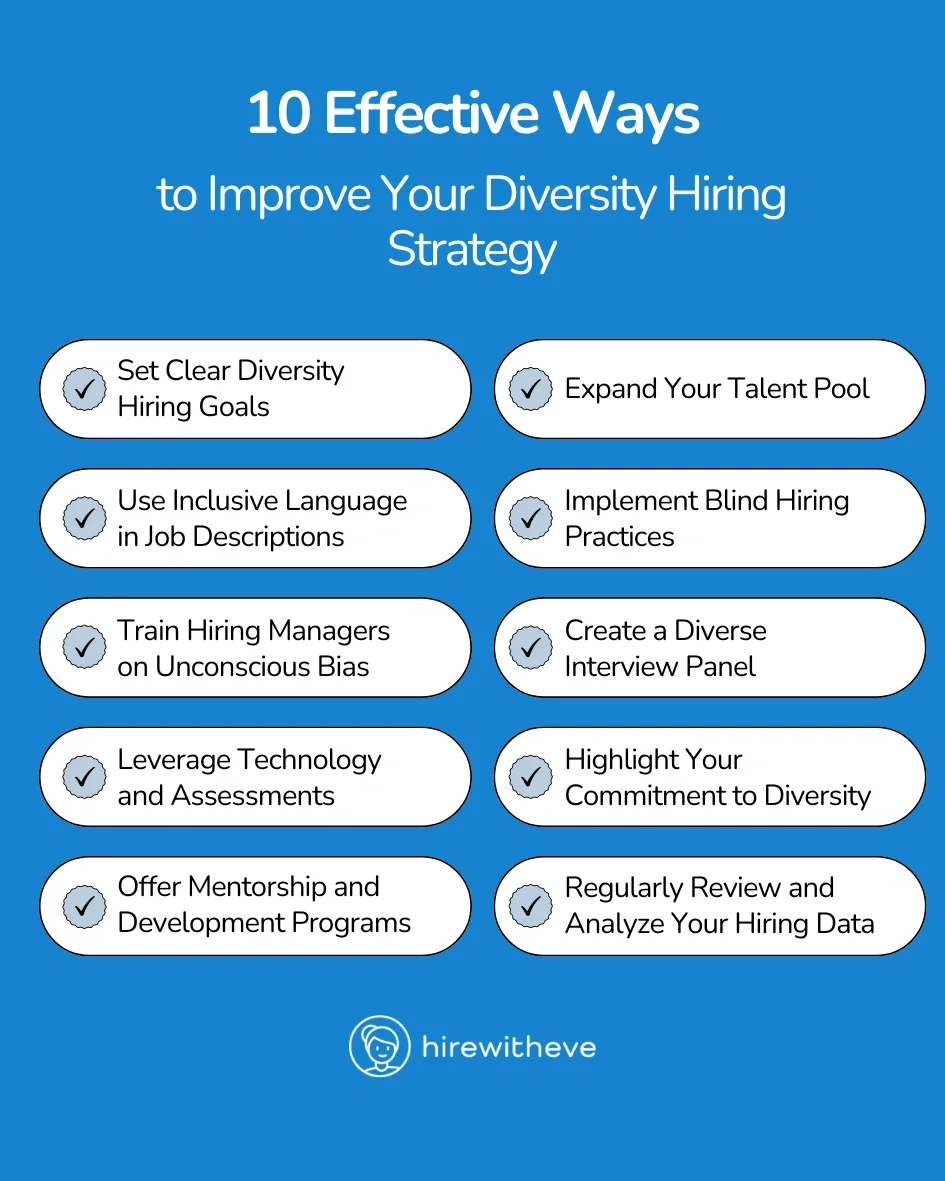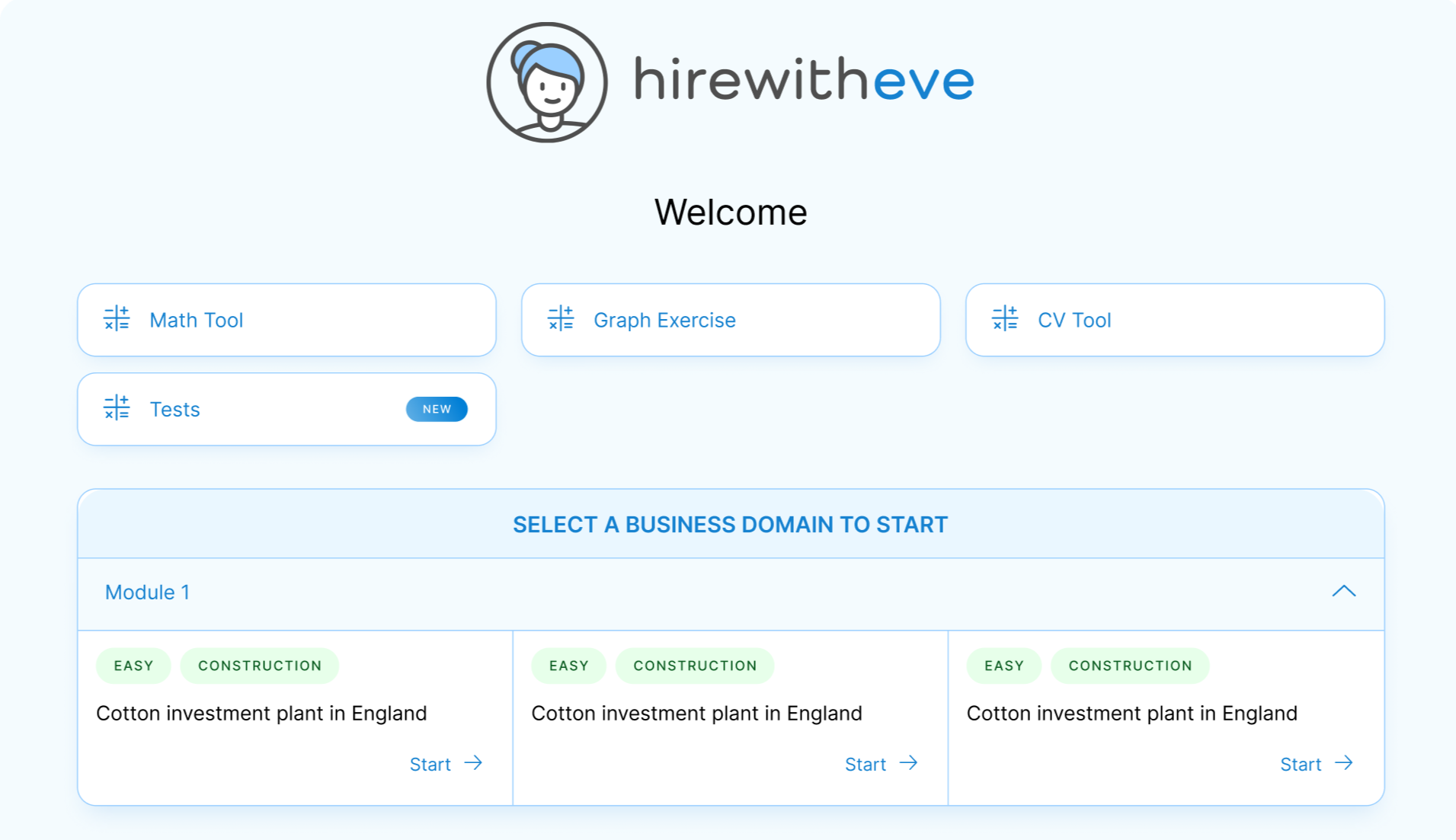10 Powerful Ways to Improve Your Diversity Hiring Strategies

In today’s evolving workplace, improving diversity isn’t just a buzzword — it’s a crucial factor for driving innovation, creativity, and success.
However, building a truly diverse team requires intentional strategies and a thoughtful approach. In this blog, we’ll explore 10 powerful ways to improve your diversity hiring strategies, helping you attract top talent from all backgrounds and create a more inclusive, equitable environment for your organization.
Let’s dive into actionable steps that can transform your hiring process and make a real impact:
Table of contents
What is Diversity Hiring?
Diversity hiring refers to a recruitment process designed to identify and attract a broad range of candidates from various backgrounds, including but not limited to race, gender, age, sexual orientation, religion, disability, socioeconomic status, education, and cultural experiences.
The goal of diversity hiring is to eliminate bias, promote inclusion, and ensure that individuals from underrepresented or marginalized groups are given equal opportunities to apply, be evaluated, and ultimately join the workforce.
What Is the Importance of Diversity Hiring?
The importance of diversity hiring extends beyond simply filling quotas or meeting legal requirements. It plays a crucial role in fostering innovation, enhancing problem-solving abilities, and creating more equitable work environments.
Here’s a detailed look at why diversity hiring is important:
Improves Innovation and Creativity
Diverse teams bring together people with different perspectives, experiences, and backgrounds, which leads to a greater variety of ideas. When individuals approach problems from different angles, it sparks innovation and fosters creative solutions. Research has shown that diverse companies are more likely to introduce new products and services, making them more competitive in the marketplace.
Improves Decision-Making
A diverse team is more likely to challenge assumptions, consider a wider range of options, and approach problems more thoughtfully. This diversity of thought leads to more informed and balanced decisions. Studies indicate that teams made up of diverse individuals outperform homogeneous teams, particularly when it comes to complex decision-making and problem-solving.
Reflects a Diverse Customer Base
For many businesses, their customers are from various backgrounds. A workforce that reflects this diversity is better equipped to understand and meet the needs of a diverse customer base. Employees from different demographics can offer insights into how products or services may be perceived by different groups, helping companies tailor their offerings and improve customer satisfaction.
Enhances Employer Branding
Companies that prioritize diversity hiring are seen as more inclusive and forward-thinking, which improves their reputation. A strong commitment to diversity makes the organization more attractive to potential employees, especially among younger generations, who often prioritize diversity and inclusion when evaluating potential employers. It also enhances the company’s reputation among customers, partners, and stakeholders who value inclusivity.
Increases Employee Engagement and Retention
A diverse and inclusive workplace makes employees feel more valued and respected, leading to higher levels of engagement. When people feel included and accepted, they are more likely to contribute fully and remain committed to the organization. This improves overall job satisfaction and can reduce turnover, saving companies money in recruitment and training costs.
Strengthens Company Culture
By embracing diversity, companies cultivate an open and inclusive culture where employees can thrive regardless of their background. This type of work environment encourages open communication, mutual respect, and collaboration across departments and teams. Over time, this creates a more cohesive and productive workforce, where everyone feels comfortable contributing their ideas and expertise.
10 Effective Ways to Improve Your Diversity Hiring Strategy
Here are 10 effective ways to improve your diversity hiring strategy:

Set Clear Diversity Hiring Goals
Establish specific, measurable diversity goals for your hiring process. This could involve increasing the percentage of hires from underrepresented groups or ensuring a diverse slate of candidates for every role. Clear goals give your organization something tangible to work toward and help you measure progress.
Expand Your Talent Pool
Widen your search beyond traditional recruitment methods. Partner with diverse job boards, professional associations, and universities that cater to underrepresented groups. Attend diversity-focused job fairs and networking events to connect with a broader talent base.
Use Inclusive Language in Job Descriptions
The wording in job descriptions can significantly influence who applies. Avoid gendered language, jargon, or unnecessary qualifications that may deter diverse candidates. Instead, focus on the key skills and experience required for the role and use neutral, inclusive language to welcome applicants from all backgrounds.
Implement Blind Hiring Practices
Blind hiring removes identifying information—such as name, gender, age, or educational background — from resumes during the initial review process. This helps prevent unconscious bias from influencing decisions and ensures candidates are evaluated based on their skills and qualifications.
Train Hiring Managers on Unconscious Bias
Conduct regular training sessions to help hiring managers recognize and overcome unconscious biases in the recruitment process. Educating your team on how biases can affect decision-making will lead to more objective and equitable hiring practices.
Create a Diverse Interview Panel
A diverse interview panel can bring multiple perspectives to the evaluation process and help eliminate bias. This also signals to candidates that your organization values diversity at all levels and fosters an inclusive culture.
Leverage Technology and Assessments
Utilize hiring assessment tools like HirewithEve to objectively evaluate candidates based on their skills, qualifications, and potential fit for the role. These tools help ensure a fair, data-driven selection process, reducing the impact of biases that can affect decision-making.
Highlight Your Commitment to Diversity
Showcase your company’s commitment to diversity and inclusion on your careers page, social media, and job postings. Highlight employee resource groups (ERGs), diversity initiatives, and the steps your company is taking to create an inclusive workplace. This will attract candidates who value and seek out diverse environments.
Offer Mentorship and Development Programs
Create mentorship and professional development programs for underrepresented groups within your organization. These programs provide employees with opportunities for growth and advancement, which can also make your company more attractive to diverse talent.
Regularly Review and Analyze Your Hiring Data
Continuously monitor and assess your diversity hiring metrics to identify areas for improvement. Track applicant demographics, interview-to-hire ratios, and retention rates for diverse hires. Use this data to adjust your strategy and ensure you are meeting your diversity goals.
Conclusion
Improving your diversity hiring strategy is not just about meeting targets — it’s about building a workforce that reflects different perspectives, experiences, and ideas, which ultimately leads to innovation and growth.
By setting clear goals, implementing unbiased hiring practices, and fostering an inclusive environment, you can create a stronger, more diverse team.
To make this process even more effective, platforms like HirewithEve provide data-driven assessments that help ensure candidates are evaluated based on skills and potential, minimizing bias in decision-making. As you refine your diversity hiring approach, tools like HirewithEve can be a game-changer in creating a fair, inclusive recruitment process.
Target Your Talent
Unlock tailored solutions for your recruitment and hiring needs with Eve Platform's extensive case study library.
Subscribe now to enhance your HR expertise and excel in your role.
Free Resources

Transforming Hiring: 7 Key Recruiting Metrics
Enhancing recruitment processes with data-driven insights for better hiring outcomes.

Reducing Hiring Bias with Hirewitheve.
Utilizing Hirewitheve to combat bias and streamline recruitment processes effectively.

Hiring Detail-Oriented Candidates
HirewithEve enhances hiring by accurately assessing candidate's attention to detail-oriented.








